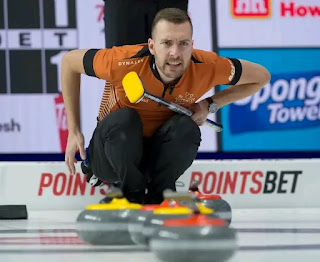Curling 101: Strategy and techniques you need to know
The Team
A curling team has five players. The one who shoots first is the lead. The skip is the boss of the team and tells the others what to do. He usually shoots last, but he can play any position. When he is not shooting, he stands behind the target and shows where to aim with his broom. When the skip is shooting, the vice-skip does his job. The vice-skip is usually the third player, but it could be the lead or the second.
All four players have a part in each shot. The shooter slides the stone, and the skip guides him. The other two players sweep the ice to make the stone go faster or slower.
 |
| Curling 101: Strategy and techniques you need to know |
Types of shots
The main thing in curling is choosing the best shots. There are many kinds of shots:
Draw: A shot that stops inside or close to the target (the circles at the end of the ice). This is how you get points.
Freeze: A kind of draw that stops right next to another stone.
Guard: A shot that stops outside the target and blocks the way for the other team.
Hit-and-roll: A shot that hits an enemy stone and then moves to a different spot. You can also hit-and-roll your own stone.
Peel: A shot that hits another stone hard and makes both stones go out of play.
Raise: A shot that hits a stone and pushes it to a new position.
Takeout: A shot that hits an enemy stone and makes it go out of play. If you take out a guard, it's called a peel.
These are just the basic shots. In high-level games, you might see more complicated shots. For example, a "raise-takeout" is when you hit a stone and make it hit another stone, which goes out of play.
In-turn vs. Out-turn
Besides picking the kind of shot, the skip also tells his teammate throwing the stone whether to play an in-turn or an out-turn. An in-turn is when you turn your palm towards your body when you let go of the stone. An out-turn is when you turn your palm away from your body.
Stones bend, or curl, as they go down the ice - that's why it's called curling. Players make the stone spin with the handle; the curl helps them control it better and also lets them shoot around other stones. For a right-handed player an out-turn curls from right to left and an in-turn curls from left to right. The way the stones are on the ice decides which kind of shot the skip calls.
The Hammer
The last shot of an end is called the hammer. The team that shoots last has an edge. A team will sometimes let the other team get a point so they can keep the hammer for the next end. (The team that gets one or more points shoots first in the next end, while the team that gets zero points keeps the hammer.)
The team with the hammer will sometimes "blank" the end. This means that instead of getting one point in the end, they will make sure no one gets any points, so they can keep the hammer for the next end. It is a win for the team without the hammer if they make the other team get only one point. Most of the time, the team with the hammer would rather keep it than get one point. A team will almost never blank an end if they can get two or more points.
Playing with The Lead
If a team has a big lead going into the last few ends, it will usually play very safe. The team with the lead will play lots of takeout shots and try to keep the ice clear of stones. The idea is that if there are not many stones on the ice, there is less chance to mess up and let the other team get lots of points and catch up.
If a team is behind by more than a few points going into the last ends, it will play very risky, trying to get as many stones on the ice as possible, and make a chance to get lots of points in one end. This strategy works because of the Free Guard Zone Rule. The Free Guard Zone is between the line and the target. During the first four stones of an end, no stone in this area can be taken out by the other team.


.jpg)


